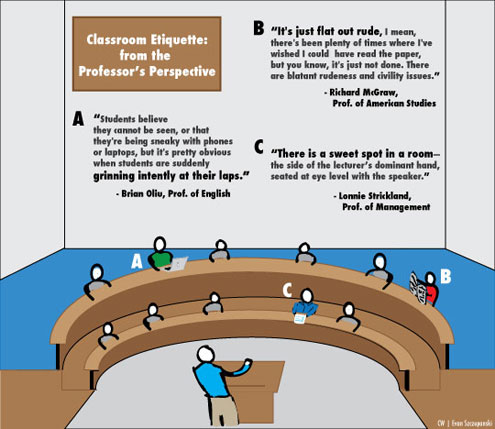 Walking into a classroom and choosing where to sit is usually something students do without hesitation. It almost becomes routine. Some are back-row people, others prefer seats against the wall. Research suggests, however, that the seat a student chooses in a classroom can tell a lot about them and even affect how a professor perceives them.
Walking into a classroom and choosing where to sit is usually something students do without hesitation. It almost becomes routine. Some are back-row people, others prefer seats against the wall. Research suggests, however, that the seat a student chooses in a classroom can tell a lot about them and even affect how a professor perceives them.
Dr. Lonnie Strickland, professor of strategic management in the business school, has his own theory in regards to where students sit in the classroom.
Strickland teaches his students, whom he refers to as customers, how to gain a competitive advantage in the business world. He says that sometimes all it takes to get noticed is your choice of where to sit in a meeting room.
Strickland said that there is a sweet spot in a room—the side of the lecturer’s dominant hand, seated at eye level with the speaker. To demonstrate his theory, Strickland sketched a diagram of his auditorium and circled a few rows on the right side in the middle area showing this optimum seating area.
“What happens is when a right-handed person is lecturing, when they are looking, they tend to look to the right,” Strickland said.
A good professor or speaker would walk around the room to incorporate different parts of the room in their sweet spot, Strickland said. However, amateur lecturers are limited to this one specific area, making anyone in other areas of the room less likely to get noticed.
“If you sit in the back row, you are detached from the class,” Strickland said. “Participation is a large portion of the grade in my class. If you are shy, in the back of the room or against the wall, the odds of getting noticed are close to none.”
Many studies have been done about the performance of students based on where they sit in the classroom, but the results are always subjective. Is it that good students with higher GPA’s just prefer to sit toward the front? If a bad student was moved to the front would their grades actually improve? The effects of where you sit in a classroom may be more of a correlation than a cause.
Psychology professor Dr. Philip Gable says that if students are looking to improve their grades, moving to the front of the classroom would most likely be a wise choice.
“Students in the front are less likely to text or be on Facebook,” Gable said. “They are more apt to pay attention because they do not have the whole room to look at and distract them.”
Gable also says that he engages more with students that are closer to the front, and they are more than likely the most willing to engage with him. In large auditoriums, the people in the back half of the room tend to be forgotten by the lecturer. To avoid this, Gable says he often will purposefully try to teach to the back half of the room.
As to whether or not professors actually judge students based off where they are sitting in the classroom, it is hard to tell.
“One does judge attributes about people based off of body language and facial expressions, such as if a person is uninterested,” Gable said. “It is a natural thing to do.”
However, Gable admits that there are exceptions to every situation.
“You can’t judge attributes simply off where someone sits. I have had students that sit in the very back corner that ask the most questions.”







